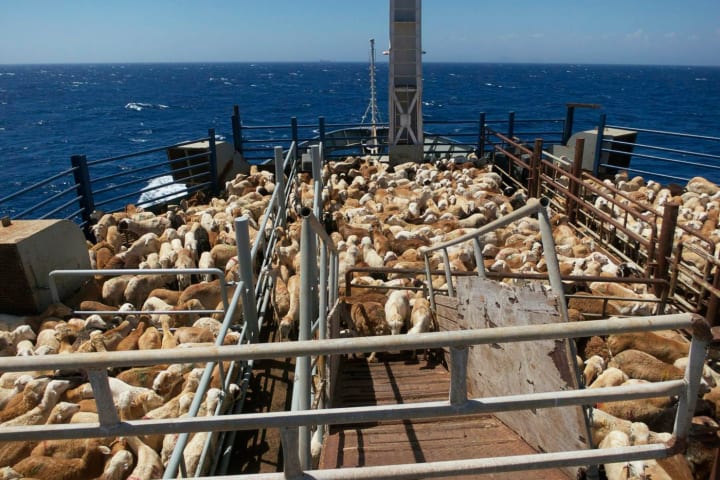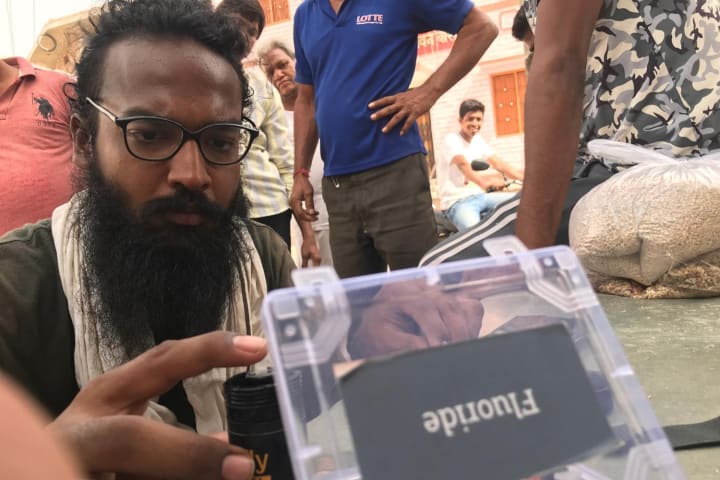IDEA SET
IDEA SET
Exploring Water with the Out of Eden Walk
Exploring Water with the Out of Eden Walk
Explore diverse stories of the role of water in human lives with National Geographic Explorer and journalist Paul Salopek. Analyze stories of water from around the world and challenge students to identify stories from their own communities.
Grades
5 - 12
Subjects
Social Studies, English Language Arts, Geography, Anthropology, Storytelling, Conservation, Earth Science

Paul Salopek
National Geographic Explorer Paul Salopek is walking 24,000 miles across the planet, following the path of early human migration from East Africa to South America and capturing local stories as he travels. This slow journey across the Earth, which he calls the Out of Eden Walk, gives him a human perspective on the major stories of our time. You can introduce students to Paul’s walk with this short video and access all of the stories from Paul and his walking partners here.
This idea set provides tools to examine stories about water from the Out of Eden Walk with students. It is one of a series of Idea Sets exploring important ideas and themes addressed by stories from the Out of Eden Walk. In each of these Idea Sets you will find resources from the walk along with classroom activities and learning tools to support your exploration of these concepts with your students.
This idea set is part of a collection called Out of Eden 10th Anniversary: Water.

Building Background Knowledge: The Role of Water in Our Daily Lives
Before exploring dispatches from the Out of Eden Walk, take some time to activate prior knowledge and build background knowledge on the vital role that water plays in our lives and water related environmental issues. First, ask students to brainstorm ideas in small groups and create webs on chart paper – using pictures and words – on one of the following questions:
“Why is water important to the environment?” and “How do we use water in our daily lives?” Direct groups to share their ideas or conduct a gallery walk. Lead a whole group discussion to summarize student ideas on the sources and importance of water.
Use the Key Concepts tool to have students define and provide examples of important ideas and terms that they will encounter as they discuss the Out of Eden Walk materials. Terms could include:
- Drought
- Flood
- Monsoon
- Groundwater
- Evaporation
- Contaminant
- Wastewater
- Watershed
- Conservation
- Agriculture
- Climate Change
- Bodies of Water (Lake, Sea, River, Ocean)

Stories of Water from the Out of Eden Walk
Paul Salopek, his walking partners, and other collaborators have collected many stories related to human interaction with water along the Out of Eden Walk. The following stories reveal some of the various impacts of water on daily life that they have encountered along the journey.
The articles, regular dispatches written by Paul throughout his journey, are available at three reading levels. There are also multimedia resources from the walk: “milestones” are snapshots Paul records every 100 miles on the trek. These contain videos, panoramic photographs, and brief interviews with the first person he encounters at each location. Walking tours include interactive maps with photos and narration that guide readers through key locations along the route. Consider assigning different articles to groups of students in your class for analysis and discussion. Students can locate the regions Paul and his walking partners visit using National Geographic Mapmaker. Other cooperative learning activities such as stations and jigsaw would also work well for exploring these resources (more specific activities and tools are included in the next section).
- Red Sea: (milestone) Paul journeys from Africa toward the Middle East on a ship packed with farm animals. He interviews a young seaman and shares images and video of the voyage.
- Shorelines: (article) When Paul visits a university on the shores of the Red Sea, he speaks to a scientist studying underwater salt pools and reflects on how life changes at shorelines.
- Uniting Heaven & Earth: Saving the Kidron-Nar Basin: (article) Israelis and Palestinians work together to restore the heavily polluted Kidron-Nar Creek.
- These Waters Carry the Ghosts of Ancient Empires: (article) In Uzbekistan Paul walks along the historic Amu Darya river and records stories of the people who must share its slowly drying waters.
- Heart Like a Wheel: (article) An Afghan man and his son work as waterwheel millers. They use the waterwheel to crush grain into flour.
- Greenness: (milestone) Clean groundwater is in short supply in India causing moisture loss and decreasingly fertile ground. Consequently, farmers have made changes in the crops that they grow.
- New Map: River Roads of India: (article; includes hyperlink to interactive story map) In India, Paul describes a water crisis where nearly half of India’s population is facing a critical shortage of drinking water or polluted water. Areas with high population, such as the Ganges Watershed, face severe water scarcity.
- Growing Up in Yunnan: In this chapter from the Out of Eden Walk podcast, walking partner Zhang Mei shares memories of growing up near a high mountain lake in Yunnan province, China.
- Indus River Dolphins: In this podcast chapter, walking partner Arati Kumar-Rao remembers her walk along the Indus River and an unexpected encounter with rare dolphins.

Explorer Mindset: Understanding the Importance of Water with the Out of Eden Walk
As your students explore the Out of Eden Walk, use the Learning Tools below to look more closely at what these stories can reveal about water.
- Use the See, Think, Wonder Learning Tool with the Red Sea or Greenness Milestone, or a striking image from the interactive story map linked to the article, “New Map: River Roads of India”. You may want to assign different images to different student groups, then have groups share. Collect student questions and categorize them to identify topics for more exploration.
- Break students into small groups, assigning each group an article to read - or a podcast to listen to - and discuss. Have students use the Save the Last Word for Me discussion protocol to examine the source closely. As they read or listen, ask them to choose their passage based on what it shows about how humans interact with water and/or are impacted by water related issues in their communities.
- Conduct a structured group discussion with your students to analyze the links between stories. Use the Socratic Seminar format from the Conducting Powerful Conversations Learning Tool to help students think critically about and make connections between the varied stories of water from the Out of Eden Walk and other resources you may be using in your classroom. Use the guiding questions below to begin the discussion. Encourage students to speak to each other and use examples from the texts:
- What was the most surprising thing you learned from these stories? Why did that surprise you?
- What are some of the similarities between the stories of water we have seen? What are some of the differences?
- What are the effects of polluted water and water scarcity on communities? How do people change their daily living habits to adapt to these issues?
- How have the stories of water in the Out of Eden Walk changed the way you think about water in our community? Why has this changed?
You may want to “fishbowl” your classroom discussions to allow smaller groups to discuss while the larger group observes. See the Learning Tool for more details on this practice.

Extensions: Exploring the Role of Water in Your Community
Let your students become the Explorer! Connect the stories of water from Out of Eden Walk to stories of water in your own community.
- Create a walking tour of your community with stops that highlight the role of water (e.g., water bodies and features, fire stations, water treatment plants, farms, etc.) in your area. Each map will vary depending on what is present in your area. Use National Geographic Mapmaker to print a map of your community and chart a walk with different stops.
- Read stories from the Out of Eden Walk HomeStories project and select three to four stories that highlight the role of water in daily life and the impact of water related issues in communities to explore more deeply. Encourage students to choose from a variety of regions using the HomeStories map. They can use thinking maps to compare and contrast the water stories shared in various entries, identifying similarities and differences among the responses. In small groups, students can share their reflections on the HomeStories they selected. Students can also create their own HomeStories as a possible home extension (requires an original photo).
- Encourage your students to join National Geographic's Slingshot Challenge! The Challenge asks youth ages 13-18 to submit a one minute video outlining an innovative solution to an environmental issue. Students can choose an environmental issue related to water for more in-depth exploration. They could explore a local community based issue and/or one related to their reading from the Out of Eden Walk. Note that video submissions are due in February each year. However, students can use the challenge materials to develop videos at any time.
Media Credits
The audio, illustrations, photos, and videos are credited beneath the media asset, except for promotional images, which generally link to another page that contains the media credit. The Rights Holder for media is the person or group credited.
Editor
Text Levels
Web Producer
Instructional Designer
With help froms
Last Updated
May 9, 2024
For information on user permissions, please read our Terms of Service. If you have questions about how to cite anything on our website in your project or classroom presentation, please contact your teacher. They will best know the preferred format. When you reach out to them, you will need the page title, URL, and the date you accessed the resource.
Media
If a media asset is downloadable, a download button appears in the corner of the media viewer. If no button appears, you cannot download or save the media.
Text
Text on this page is printable and can be used according to our Terms of Service.
Interactives
Any interactives on this page can only be played while you are visiting our website. You cannot download interactives.